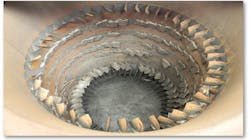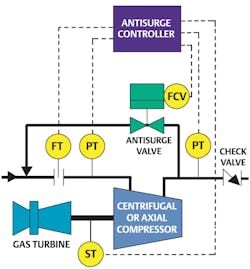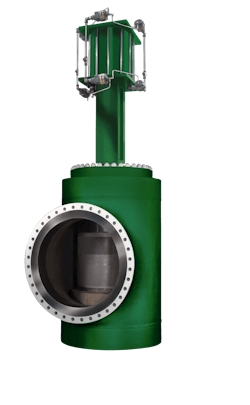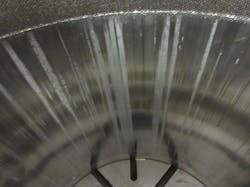Axial and centrifugal compressors are critical to many processes. Driven by a turbine or large motor, they use spinning blades on a rotor to efficiently raise vapor pressure and feed reactors, refrigeration systems and a wide variety of other process equipment. While simple in concept, these types of compressors are prone to surge — a potentially catastrophic condition that can occur suddenly and without warning.
This article explains how this problematic condition transpires, how to prevent it, and how a new feature called engineered flow deadband can be utilized to improve system reliability.
Clarifying compressor surge
Surge occurs when either the suction intake or discharge outflow of a compressor is blocked or restricted. Consider a compressor running at rated capacity with a valve on the discharge that is being slowly closed. As the restriction imposed by this valve increases, the discharge pressure of the compressor rises to compensate, and the resulting flow through the compressor falls.
If the valve closes further, the pressure continues building to a point where the compressor can no longer overcome the resistance, and flow will stall. As the flow drops and the vapor inertia is lost, the compressor cannot contain the pressure at its outlet, and suddenly, the pressurized gas relieves backwards through the compressor section. As soon as the pressure releases, the still spinning compressor immediately pushes the gas forward again, building pressure and setting up the next surge cycle.
The rate of the surge varies from a cycle every few seconds to multiple cycles per second for high-speed compressors. A few surge cycles will usually damage the thrust bearings, and if the condition is allowed to continue, surge can utterly destroy the compressor internals (Figure 1).
If the surge condition is not immediately alleviated, the resulting damage can cost hundreds of thousands of dollars to repair, and the compressor may be out of commission for weeks and even months leading to lost throughput.
Anti-surge to the rescue
Surge must be avoided, and this is accomplished with an anti-surge control system (Figure 2). Anti-surge control consists of a number of instruments measuring critical operating parameters including compressor speed, inlet pressure and flow, discharge pressure, and often inlet and outlet temperature.
These values are fed into a high-speed, dedicated controller that has been programmed with the operating performance map of the compressor. The measured process data and compressor map allow the controller to predict when surge will occur, and the instrumentation enables the controller to detect surge conditions should they unexpectedly occur. In either case, the anti-surge controller opens the anti-surge valve to immediately recycle process from the discharge to the suction side of the compressor in order to maintain adequate forward flow or reestablish flow in the forward direction.
The anti-surge valve is normally closed, but if the compressor is operating at low capacity, the anti-surge controller may keep the valve partially open to maintain minimum compressor throughput and avoid surge. Operation in this manner is very inefficient but unavoidable if the compressor is to be protected.
Not your father’s control valve
The anti-surge valve is a critical component of the anti-surge control system (Figure 3). It is often a large control valve designed to take the entire throughput of the compressor at high pressure drop conditions, with higher capacity compressors requiring 24-inch to 30-inch control valves or even larger.
The anti-surge valve is also designed to be fast. Imagine a 30-inch valve capable of moving from 0 to 100% travel, or any position in between, in under two seconds while maintaining precise control. This is accomplished using high precision positioners, pneumatic boosters, air volume tanks and careful engineering and testing.
Unexpected failure
When a critical valve like this fails to function as designed, it receives a lot of attention very quickly. This situation recently occurred in a plant that had installed a new anti-surge valve on a compressor during a major overhaul. Shortly after returning the compressor to operation, the plant needed to take the unit offline, so they tried to open the anti-surge valve to unload the compressor in a controlled manner. However, the valve would not respond to the control signal change, forcing the plant to take the compressor down. The failure of the new valve to move as expected demanded investigation.
A large group of plant operations and maintenance personnel, along with vendor representatives, were on hand when the valve was pulled from the line and inspected. They found that the valve plug was stuck in position, requiring a hydraulic press to remove it from the cage. Thousands of tiny metal pellets were found caught in the clearance area between the cage and plug and inside the small flow passages that make up the cage. The small size of these flow passages is key to providing flow while reducing aerodynamic noise, which is a common concern in these applications. It was later discovered that these pellets resulted in the plug seizing inside the cage, (Figure 4), thereby preventing the valve from responding to the control signal change.
Further investigation revealed the source of the pellets was a failed media filter upstream of the compressor. The plant had been extremely lucky. If the valve had been called upon to protect the compressor from surge, it could not have functioned, and the compressor would probably have been destroyed.
Early detection
The filter was repaired and the pellets were removed, and the valve was then refurbished and returned to service. However, a critical question remained. How could the plant know the valve would function when called to act in the future?
This is a typical concern of many such long-standstill services, as it is especially important that these types of valves respond in the rare event they are required. Even outside of the example mentioned, there are many other examples where unresponsive anti-surge valves caused a unit or facility shutdown. In safety instrumented system applications, this type of responsiveness or probability of failure on demand can be diagnosed using a tool called partial stroke testing (PST).
A PST could certainly assist in confirming an anti-surge valve’s functionality and availability, but it can also provide continuous insight into the overall health of the valve assembly, which would give the plant more information to determine when and if maintenance is required. In fact, a PST performed with digital positioners often collects an array of different variables, which can be analyzed to determine common failure scenarios including sticking valve trim, loose air connections and improperly tightened valve packing, just to name a few. Unfortunately, performing a PST on a normally closed anti-surge valve, or even just barely cracking such a valve off its seat, creates a substantial drop in discharge pressure and diverts compressor flow from the downstream process, causing significant process upsets. The plant in the above example needed a way to move the valve enough to prove it worked without passing enough flow to disrupt unit operations.
Engineered flow deadband
The solution was a modification to the valve trim that allowed the valve to move enough to complete the PST and collect useful data while passing minimal flow during the test. This enabled the plant to perform PSTs as often as desired, each with minimal process impact.
The modification to the valve trim added a small section of engineered flow deadband. This is a small area where the valve closure member actually travels but only allows minimal flow to be realized. When this engineered flow deadband is aligned with the required PST travel requirements, it allows the user to execute a PST on a normally closed valve and introduce a minimal – and acceptable – process disturbance.
It is important to make sure the engineered flow deadband provides enough travel range to gather meaningful diagnostic data; otherwise, the test is useless. The engineered flow deadband must be carefully evaluated before application because it may affect valve capacity, total travel, stroking speed, aerodynamic noise attenuation capability and instrumentation selection. But when properly applied, it allows for the diagnostic evaluation of valves that would normally be impossible to test while the process is running.
Such valve modifications also require adjustments to the anti-surge controller configuration, which must move quickly through this flow deadband to avoid instability at low flow conditions.
Engineered flow deadband offers significant benefits. Routine partial stroke tests dramatically improve the reliability of these critical valves, and the engineered flow deadband makes it possible to conduct these tests with minimal process disturbance. This high level of reliability can also allow a compressor to operate closer to the surge line during low demand conditions, improving overall plant efficiency significantly.
Conclusion
Control valves with engineered flow deadband can be an excellent choice for long-standstill, critical applications, such as anti-surge control. Ordinarily, even a small PST performed on valves in this service negatively and severely affects downstream operations, but the modified trim design with engineered flow deadband provides full PST benefits with minimal impact to operations.
Engineered flow deadband does require control system adjustments to avoid instability at very low flows, and it can slightly reduce the maximum valve capacity if the travel is not compensated, but the benefits associated with frequent PST can be dramatic. Reliability of severe-service valves is greatly enhanced, and this confidence can enable tighter surge control, along with improved plant efficiency during low-capacity operation.
Justin Miller is a senior sales engineer for Emerson’s flow controls products, specializing in the chemical industry. Previously, he had spent seven years in product management where he supported Fisher Sliding-Stem valves including Fisher Optimized Anti-Surge Valve solutions. He is a Certified Functional Safety Professional with 10 years of valve application and product management experience, and he strives to help customers find the best possible solutions to challenging applications. Miller holds a Bachelor of Science in mechanical engineering from Iowa State University.
Loyd Hilliard is the technical specialist supervisor for Puffer-Sweiven’s EPC Sales Business Unit. For the past 25 years, Hilliard has held various roles dedicated to the sizing and selection of control valves and their accessories in severe and critical applications. His current role concentrates on providing technical support to global engineering organizations for control, isolation and safety valve applications. Hilliard holds a Bachelor of Science in mechanical engineering from Texas A&M University.





